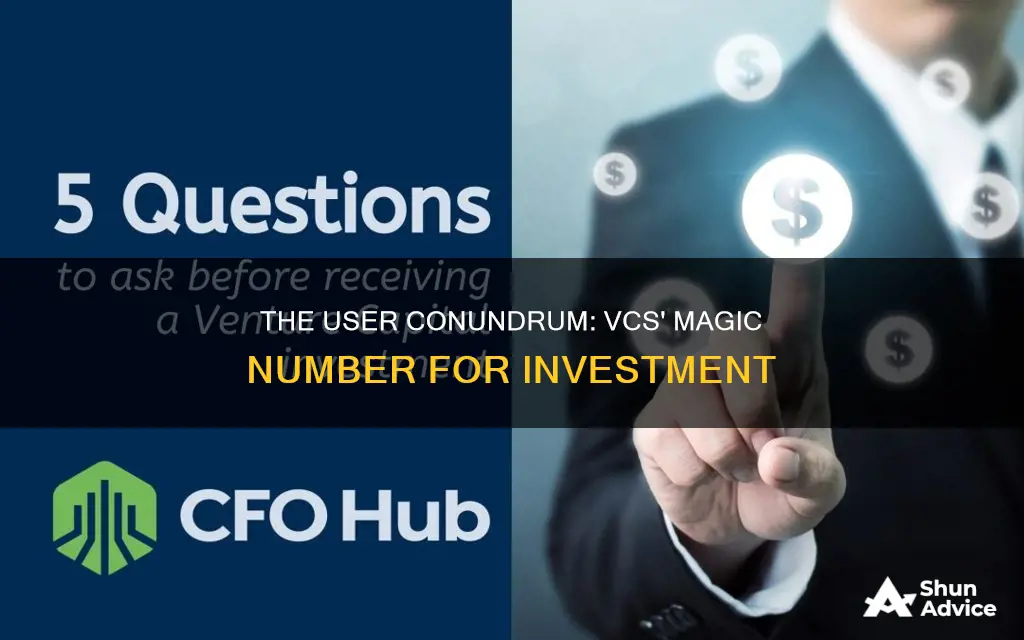
Venture capitalists (VCs) are money management organisations that raise money from various sources and invest in startups. VCs play a crucial role in the economy by financing high-growth startups, such as Amazon, Apple, Facebook, and Google. While the number of users is not the sole factor in VC investment decisions, it is an important indicator of market traction and product demand. Startups with early traction, such as beta products, initial customers, and strategic partnerships, are more likely to obtain VC funding.
VCs typically invest in startups with high growth potential and seek to maximise their returns. They consider factors such as the management team, market opportunity, traction, founder passion, financial projections, and intellectual property when deciding whether to invest. VCs also tend to focus on specific industries, stages of development, or geographic regions that align with their investment thesis.
To increase the chances of securing VC funding, founders should create a professional pitch deck, seek introductions from trusted colleagues, and demonstrate their unique value proposition. It is essential to approach the right investors, considering factors such as size, geography, industry focus, and the availability of funds.
What You'll Learn

How to create a pitch deck for VC funding
While there is no exact number of users that will convince a VC to invest, VC firms typically make investments according to a particular thesis – for example, supporting startups in a particular stage, industry, or geographic region. A VC firm's investment thesis could include investing in companies that can scale and bring together huge groups of people, as is the case with Union Square Ventures (USV).
Now, here's how to create a pitch deck for VC funding:
A pitch deck is a crucial tool for securing VC funding. It should be concise, compelling, and focused on highlighting the potential of your company. Here are some guidelines to create an effective pitch deck:
Tell a Story:
Investors want to see a cohesive and compelling story that demonstrates your company's inevitable success. Your pitch deck should be more than just facts and figures; it should narrate the journey of your company, its unique value proposition, and its future prospects.
Focus on the Investor's Perspective:
Remember that the primary goal of investors is to generate substantial returns on their investments. Your pitch deck should answer the question, "Why should investors invest in your company?" Emphasize how your company will enable investors to multiply their money, addressing the 50x-100x return expectation of seed investors.
Highlight Core Strengths:
Identify the 2-3 most convincing aspects of your pitch, such as your team, market, traction, product, or fundamental IP. Build your narrative around these strengths and use them to showcase the potential of your company.
Describe Your Product:
Explain your product or service concisely and clearly. Focus on answering the "why" question by highlighting the end-user benefits and the consumer problem your product solves. If possible, demonstrate your product through a live demo or provide good visuals and videos to showcase it effectively.
Assess Your Market:
Provide an honest and realistic assessment of your market. Use industry standards, benchmarks, and comparable product successes to support your projections. Address your total addressable market (TAM), serviceable addressable market (SAM), and serviceable obtainable market (SOM). Be prepared to discuss your scaling strategy when you achieve success.
Showcase Your Team:
Investors invest in people as much as they invest in ideas. Showcase the credentials, backgrounds, and successes of your team. Highlight any exceptional accomplishments, domain expertise, or unique perspectives that make your team well-suited to solve the specific problem your company addresses.
Address Challenges and Competition:
Be candid about the challenges you face and how you plan to overcome them. Address your potential competitors and explain how you can gain an advantage in the market. Show that you have a realistic understanding of the opportunities and obstacles ahead.
Keep it Concise and Well-Designed:
Your pitch deck should be easy to scan and packed with valuable information. Keep the design professional and ensure it aligns with your brand image. Avoid overly produced or slick decks, as they may suggest a misalignment of priorities. Focus on substance and ensure your deck delivers key information effectively.
Anticipate Questions:
As you structure your pitch deck, anticipate the questions that investors may ask. Address topics like revenue growth, burn rate, and the amount you plan to raise, providing justifications for the latter. Be prepared to discuss any slide or data point that may prompt further inquiries.
Target the Right Investors:
Finding the right investors for your pitch is crucial. Research potential investors to understand their area of interest, investment theses, targeted investment size, existing portfolio, and investment climate. Tailor your pitch to align with their interests and demonstrate why your company is a good fit for their firm.
Remember that a pitch deck is just the beginning of the conversation with investors. It should spark interest and open doors for further discussions. Keep refining and improving your pitch deck based on feedback and the evolving needs of your company.
Forever Stamps: A Smart Investment?
You may want to see also

How to find the right investors
Know what you want from an investor
Before you start your search, it's important to know what you want from an investor. Are you looking for a guide to help you through the process of creating a business? Or are you purely seeking funding? Different types of investors will be more compatible with different needs.
Types of investors
There are several types of investors, including angel investors, venture capitalists (VCs), super angel investors, and private equity investors. Angel investors are typically former entrepreneurs who invest their own money. They tend to be more cautious and invest lower amounts, but they often invest in earlier stages. VCs, on the other hand, invest on behalf of limited partners and can provide larger amounts of funding. Super angel investors deal with larger sums of money, similar to VCs, but investing is their primary profession. Private equity investors, meanwhile, will take a public company and make it private, resulting in 100% ownership of the company's profits.
Where to find investors
Networking is key to finding the right investors. Attend industry events and create relationships with people in your field. Online resources such as Crunchbase Pro can also help you find valuable investor information. Accelerators are another way to connect with potential investors, as they often introduce founders to investors.
What investors look for
Investors want to see a unique business idea, a solid business and marketing plan, and knowledge of how to raise capital. They also want to see demonstrated demand or need for your product or service, as well as a clear action plan for success. It's important to be highly knowledgeable about your industry and be able to answer potential investors' questions thoughtfully and thoroughly.
Choosing the right investor
When choosing an investor, consider their reputation for funding repeat rounds of investment. Finding new investors at every round can be time-consuming and dilutive to your ownership. Also, consider the investor's interest in being a lead investor and their level of influence in your industry. Look for investors who can add value beyond just capital, such as resources and connections.
Due diligence
Don't forget to do your due diligence on potential investors. Check their funding history, the performance of their other investments, and their financial strength. Ensure they are the right type of investor for your stage of growth and that they have the capacity to invest.
Diversify your investor portfolio
Finally, consider diversifying your investor portfolio to minimise risk. For example, if you have multiple investors with a large proportion of their portfolio in one company, and that company fails, it could impact their ability to invest in your business.
Investments After Loss: A New Chapter
You may want to see also

How to assess market opportunity
Assessing market opportunity is a crucial aspect of venture capital (VC) investing. Here are some detailed guidelines on how to assess market opportunity effectively:
Understand the Industry Dynamics
Before investing, it's essential to have a clear understanding of the industry in which the startup operates. This includes identifying the competitive landscape, market trends, and growth potential. Look for industries that are competitively forgiving and have above-average growth potential. For example, industries like technology, healthcare, and internet services have attracted significant VC investments due to their dynamic nature and high growth prospects.
Evaluate the Market Size and Scalability
Most VC investors seek opportunities in markets with significant size and scalability. A "big" market opportunity typically refers to an addressable market with the potential to generate over $1 billion in annual sales. Consider the total addressable market and the startup's ability to capture a substantial portion of it over time. Assess whether the startup can scale its operations and customer base effectively to meet the market demand.
Analyze Early Traction and Customer Engagement
Look for signs of early traction, such as the development of a minimum viable product (MVP), initial customer acquisition (especially brand-name customers), strategic partnerships, and customer testimonials. These indicators demonstrate market validation and reduce the investment risk. Evaluate how the startup plans to accelerate this early traction and scale its business effectively.
Assess the Uniqueness and Differentiation of the Offering
Investors are attracted to startups with unique and differentiated products or services. Evaluate what sets the company's offering apart from its competitors. Consider the key features, product milestones, and enhancements that provide a competitive advantage. Understand the customer value proposition and why users care about the product or service.
Study the Target Customer Segment
Understanding the target customer segment is crucial in assessing market opportunity. Evaluate the size and growth potential of the target market. Analyze the demographics, needs, and preferences of the target customers. Assess whether the startup has a deep understanding of its customer base and can effectively reach and retain these customers.
Evaluate the Growth Strategy and Milestones
Investors want to see a well-defined growth strategy with clear milestones. Assess the startup's short-term and long-term goals, including expansion plans, product development roadmap, and customer acquisition targets. Understand the key performance indicators (KPIs) the company tracks and how they align with its growth strategy. Ensure that the startup has a realistic plan to achieve its milestones and can provide data-driven projections.
Analyze the Competition
As part of assessing market opportunity, it's essential to evaluate the competitive landscape. Identify the startup's direct and indirect competitors and analyze their strengths and weaknesses. Look for unique selling propositions that give the company an edge in the market. Assess whether the startup can maintain and enhance its competitive advantage over time.
Due Diligence on the Founding Team and Advisors
The quality of the founding team and their ability to execute the business plan is crucial. Evaluate the skills, experience, and track record of the founders and key team members. Assess their passion, determination, and motivation for building the business. Also, consider the involvement of experienced advisors who can provide strategic guidance and support to the founding team.
By following these guidelines and conducting a comprehensive assessment of the market opportunity, VC investors can make more informed decisions and increase their chances of identifying high-potential investments.
The Great Debate: Mortgage Freedom or Investment Opportunities?
You may want to see also

How to showcase early traction
When it comes to early-stage startups, traction is often the key to winning over investors. It is a measure of a startup's performance, demonstrating its ability to attract and retain customers, generate revenue, and achieve product-market fit. While traction can be challenging to define and varies across industries and investors, it essentially boils down to evidence that your business is likely to succeed.
Offer a Free Version:
Even if your product is software as a service (SaaS), consider providing a free version. This lowers the barrier to entry, allowing potential customers to try before they buy. It can help you build a user base and generate valuable feedback for improvements.
Showcase Growth:
Investors love profit, but they also understand that growth is a powerful indicator of future success. In your pitch deck, present month-over-month growth statistics using easy-to-read graphs. Show that your business is scaling rapidly, whether in terms of customer base, revenue, or both. This demonstrates high growth potential, which is a critical factor for investors.
Highlight Strategic Partnerships and Endorsements:
If you have established partnerships or endorsements from renowned brands or influencers in your industry, showcase them in your pitch deck. This demonstrates that your startup has gained the trust and support of established players in the market, reducing investment risk and increasing investor confidence.
Emphasize Customer Retention:
For business-to-business (B2B) SaaS companies, customer retention is crucial. Investors want to see users sticking around and becoming advocates for your product. Demonstrate that your customers are not just signing up for a free trial but are committed to using your product or service long-term.
Provide Clear Product-Market Fit:
Ensure that your product addresses a genuine market need or solves a real problem. Show evidence of market validation, such as a working prototype, early adopters, or pre-orders. This demonstrates that your product has a market fit and is not just an idea but a viable solution that customers want and need.
Demonstrate Strong Sales and Marketing Strategy:
A great product is essential, but it's also about how you present it to the market. Ensure your marketing targets the right audience, and your sales pitch resonates with potential customers. Show investors that you have a well-thought-out plan to reach and convert your target market.
Highlight User Acquisition and Growth Rate:
Investors are interested in both user growth and revenue growth. Present metrics such as monthly active users (MAUs) or daily active users (DAUs) to showcase how quickly you are acquiring new users. A high adoption rate indicates strong market demand and customer satisfaction.
Focus on Brevity, Accessibility, and Persuasion:
When creating your pitch deck, keep your traction slide concise and easy to understand. Limit it to 1-2 slides with no more than 3 bullet points each. Ensure that your key messages are clear, accessible, and likely to encourage investment.
Remember, early traction is critical for startups, and it can be achieved through proper branding, an excellent product or service, and strategic partnerships. By showcasing your startup's traction effectively, you can build investor confidence and increase your chances of securing the funding you need to take your business to the next level.
Buffett's Current Investment Strategy
You may want to see also

How to demonstrate a unique product
Demonstrating a unique product is a challenging but rewarding task. Here are some strategies to help you showcase your product's uniqueness effectively:
Understand your product and your customers:
Know your product inside out, including its unique attributes and capabilities. Get feedback from your customers to understand their perspective, needs, and pain points. This will help you tailor your message and address any potential concerns or misconceptions.
Differentiate yourself from competitors:
Identify what your competitors are missing or doing differently. Look for gaps in their products or services, and modify yours to solve those problems. For instance, you could change your business model, theme, or target a specific niche market that your competitors are neglecting.
Enhance differentiation:
Focus on existing characteristics of your product or service and find ways to enhance them. This could be through improved customer service, additional support staff, training videos, or tutorials. Combine multiple value activities to create a unique and compelling offering.
Change the rules:
If you can't beat the industry leaders at their own game, change the rules. Find unrecognised opportunities or preempt industry changes to differentiate yourself. For example, encourage users to adopt your product within an organisation without explicit permission, so it becomes integral to their operations.
Destroy industry norms:
Challenge industry conventions and turn them on their head. For instance, you could open-source your product, allowing anyone to host it on their servers, and then charge for additional tools, services, and integration.
Showcase your product creatively:
Use creative methods to demonstrate your product's value. This could include stories, testimonials, comparison charts, demonstrations, trials, metaphors, analogies, or a comprehensive FAQ section. Make your product memorable and engaging, and address your customers' emotional and rational needs.
Remember, creating a unique product is just the first step. Effective demonstration and communication of its uniqueness are crucial for attracting VC investment and achieving commercial success.
Training Investments: Why Bother?
You may want to see also
Frequently asked questions
There is no definitive answer to this question as it depends on a variety of factors, including the industry, stage of the company, and the VC firm's investment thesis. However, it is important to demonstrate early traction and a unique value proposition to increase your chances of securing VC investment.
Aside from the number of users or customers, VCs look for a strong management team, a large market opportunity, passionate and determined founders, a differentiated product or service, and realistic financial projections, among other factors.
VC firms typically invest in high-growth startups with above-average growth potential. If your company operates in a competitive industry, has a unique value proposition, and can demonstrate early traction, it may be a good candidate for VC investment.
When evaluating VC firms, consider their investment thesis, industry focus, investment stage, and fund size. Look for firms that have a successful track record of investing in companies similar to yours in terms of size, geography, and industry.
Prepare a professional and compelling pitch deck that showcases your team, product, market opportunity, competitive advantages, and financial projections. Seek introductions from trusted colleagues or advisors who have connections with the VC firm. Demonstrate your ability to execute and scale your business effectively.







